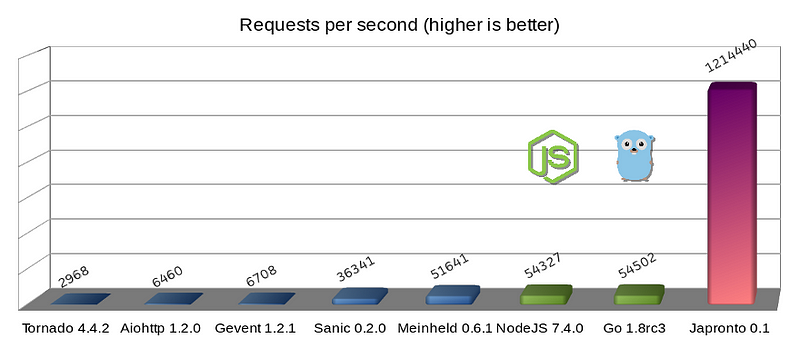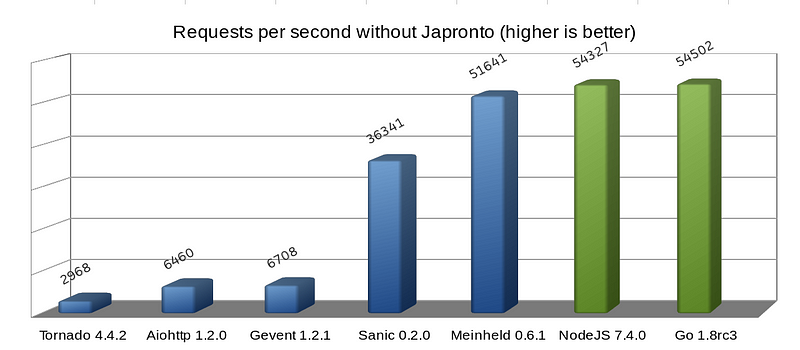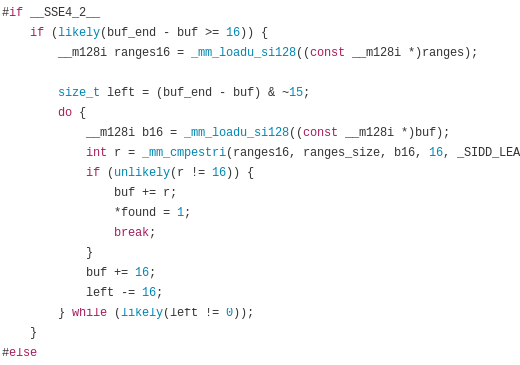A million requests per second with Python
https://medium.freecodecamp.com/million-requests-per-second-with-Python-95c137af319
Is it possible to hit a million requests per second with python? Probably not until recently.
A lot of companies are migrating away from Python and to other programming languages so that they can boost their operation performance and save on server prices, but there’s no need really. Python can be right tool for the job.
The Python community is doing a lot of around performance lately. CPython 3.6 boosted overall interpreter performance with new dictionary implementation. CPython 3.7 is going to be even faster, thanks to the introduction of faster call convention and dictionary lookup caches.
For number crunching tasks you can use PyPy with its just-in-time code compilation. You can also run NumPy’s test suite, which now has improved overall compatibility with C extensions. Later this year PyPy is expected to reach Python 3.5 conformance.
All this great work inspired me to innovate in one of the areas where Python is used extensively: web and micro-service development.
Enter Japronto!
Japronto is a brand new micro-framework tailored for your micro-services needs. Its main goals include being fast, scalable, and lightweight. It lets you do both synchronous and asynchronous programming thanks to asyncio. And it’s shamelessly fast. Even faster than NodeJS and Go.

Python micro-frameworks (blue), Dark side of force (green) and Japronto (purple)
Errata: As user @heppu points out, go’s stdlib HTTP server can be 12% faster than this graph shows when written more carefully. Also there’s an awesome fasthttp server for Go that apparently is only 18% slower than Japronto in this particular benchmark. Awesome! For details see https://github.com/squeaky-pl/japronto/pull/12 and https://github.com/squeaky-pl/japronto/pull/14.

We can also see that Meinheld WSGI server is almost on par with NodeJS and Go. Despite of its inherently blocking design, it is a great performer compared to the preceding four, which are asynchronous Python solutions. So never trust anyone who says that asynchronous systems are always speedier. They are almost always more concurrent, but there’s much more to it than just that.
I performed this micro benchmark using a “Hello world!” application, but it clearly demonstrates server-framework overhead for a number of solutions.
These results were obtained on an AWS c4.2xlarge instance that had 8 VCPUs, launched in São Paulo region with default shared tenancy and HVM virtualization and magnetic storage. The machine was running Ubuntu 16.04.1 LTS (Xenial Xerus) with the Linux 4.4.0–53-generic x86_64 kernel. The OS was reporting Xeon® CPU E5–2666 v3 @ 2.90GHz CPU. I used Python 3.6, which I freshly compiled from its source code.
To be fair, all the contestants (including Go) were running a single-worker process. Servers were load tested using wrk with 1 thread, 100 connections, and 24 simultaneous (pipelined) requests per connection (cumulative parallelism of 2400 requests).

HTTP pipelining (image credit Wikipedia)
HTTP pipelining is crucial here since it’s one of the optimizations that Japronto takes into account when executing requests.
Most of the servers execute requests from pipelining clients in the same fashion they would from non-pipelining clients. They don’t try to optimize it. (In fact Sanic and Meinheld will also silently drop requests from pipelining clients, which is a violation of HTTP 1.1 protocol.)
In simple words, pipelining is a technique in which the client doesn’t need to wait for the response before sending subsequent requests over the same TCP connection. To ensure integrity of the communication, the server sends back several responses in the same order requests are received.
The gory details of optimizations
When many small GET requests are pipelined together by the client, there’s a high probability that they’ll arrive in one TCP packet (thanks to Nagle’s algorithm) on the server side, then be read back by one system call.
Doing a system call and moving data from kernel-space to user-space is a very expensive operation compared to, say, moving memory inside process space. That’s why doing it’s important to perform as few as necessary system calls (but no less).
When Japronto receives data and successfully parses several requests out of it, it tries to execute all the requests as fast as possible, glue responses back in correct order, then write back in one system call. In fact the kernel can aid in the gluing part, thanks to scatter/gather IO system calls, which Japronto doesn’t use yet.
Note that this isn’t always possible, since some of the requests could take too long, and waiting for them would needlessly increase latency.
Take care when you tune heuristics, and consider the cost of system calls and the expected request completion time.

Japronto gives a 1,214,440 RPS median of grouped continuous data, calculated as the 50th percentile, using interpolation.
Besides delaying writes for pipelined clients, there are several other techniques that the code employs.
Japronto is written almost entirely in C. The parser, protocol, connection reaper, router, request, and response objects are written as C extensions.
Japronto tries hard to delay creation of Python counterparts of its internal structures until asked explicitly. For example, a headers dictionary won’t be created until it’s requested in a view. All the token boundaries are already marked before but normalization of header keys, and creation of several str objects is done when they’re accessed for the first time.
Japronto relies on the excellent picohttpparser C library for parsing status line, headers, and a chunked HTTP message body. Picohttpparser directly employs text processing instructions found in modern CPUs with SSE4.2 extensions (almost any 10-year-old x86_64 CPU has it) to quickly match boundaries of HTTP tokens. The I/O is handled by the super awesome uvloop, which itself is a wrapper around libuv. At the lowest level, this is a bridge to epoll system call providing asynchronous notifications on read-write readiness.

Picohttpparser relies on SSE4.2 and CMPESTRI x86_64 intrinsic to do parsing
Python is a garbage collected language, so care needs to be taken when designing high performance systems so as not to needlessly increase pressure on the garbage collector. The internal design of Japronto tries to avoid reference cycles and do as few allocations/deallocations as necessary. It does this by preallocating some objects into so-called arenas. It also tries to reuse Python objects for future requests if they’re no longer referenced instead of throwing them away.
All the allocations are done as multiples of 4KB. Internal structures are carefully laid out so that data used frequently together is close enough in memory, minimizing the possibility of cache misses.
Japronto tries to not copy between buffers unnecessarily, and does many operations in-place. For example, it percent-decodes the path before matching in the router process.
Open source contributors, I could use your help.
I’ve been working on Japronto continuously for past 3 months — often during weekends, as well as normal work days. This was only possible due to me taking a break from my regular programmer job and putting all my effort into this project.
I think it’s time to share the fruit of my labor with the community.
Currently Japronto implements a pretty solid feature set:
- HTTP 1.x implementation with support for chunked uploads
- Full support for HTTP pipelining
- Keep-alive connections with configurable reaper
- Support for synchronous and asynchronous views
- Master-multiworker model based on forking
- Support for code reloading on changes
- Simple routing
I would like to look into Websockets and streaming HTTP responses asynchronously next.
There’s a lot of work to be done in terms of documenting and testing. If you’re interested in helping, please contact me directly on Twitter. Here’s Japronto’s GitHub project repository.
Also, if your company is looking for a Python developer who’s a performance freak and also does DevOps, I’m open to hearing about that. I am going to consider positions worldwide.
Final words
All the techniques that I’ve mentioned here are not really specific to Python. They could be probably employed in other languages like Ruby, JavaScript or even PHP. I’d be interested in doing such work, too, but this sadly will not happen unless somebody can fund it.
I’d like to thank Python community for their continuous investment in performance engineering. Namely Victor Stinner @VictorStinner, INADA Naoki @methane and Yury Selivanov @1st1 and entire PyPy team.
For the love of Python.
A million requests per second with Python的更多相关文章
- (转)Making 1 million requests with python-aiohttp
转自:https://pawelmhm.github.io/asyncio/python/aiohttp/2016/04/22/asyncio-aiohttp.html Making 1 millio ...
- worker pool Handling 1 Million Requests per Minute with Golang
小结: 1. 我们决定使用 Go 通道的一种常用模式构建一个两层的通道系统,一个通道用作任务队列,另一个来控制处理任务时的并发量. 这个办法是想以一种可持续的速率.并发地上传数据至 S3 存储,这样既 ...
- python requests模块使用
python的网络编程能力十分强大,其中python中的requests库宣言:HTTP for Humans (给人用的 HTTP 库) 在网络编程中,最基本的任务包含: 发送请求 登录 获取数据 ...
- Python Requests模块讲解4
高级用法 会话对象 请求与响应对象 Prepared Requests SSL证书验证 响应体内容工作流 保持活动状态(持久连接) 流式上传 块编码请求 POST Multiple Multipart ...
- Python requests 安装与开发
Requests 是用Python语言编写HTTP客户端库,跟urllib.urllib2类似,基于 urllib,但比 urllib 更加方便,可以节约我们大量的工作,完全满足 HTTP 测试需求, ...
- Python+Requests接口测试教程(2):
开讲前,告诉大家requests有他自己的官方文档:http://cn.python-requests.org/zh_CN/latest/ 2.1 发get请求 前言requests模块,也就是老污龟 ...
- python requests库学习笔记(上)
尊重博客园原创精神,请勿转载! requests库官方使用手册地址:http://www.python-requests.org/en/master/:中文使用手册地址:http://cn.pytho ...
- python爬虫 - python requests网络请求简洁之道
http://blog.csdn.net/pipisorry/article/details/48086195 requests简介 requests是一个很实用的Python HTTP客户端库,编写 ...
- [python爬虫]Requests-BeautifulSoup-Re库方案--Requests库介绍
[根据北京理工大学嵩天老师“Python网络爬虫与信息提取”慕课课程编写 文章中部分图片来自老师PPT 慕课链接:https://www.icourse163.org/learn/BIT-10018 ...
随机推荐
- [GitHub]第七讲:GitHub issues
文章转载自:http://blog.csdn.net/loadsong/article/details/51591701 Github 上的每个项目仓库,都有三套基础设置可供使用:一个是通过 Gith ...
- String类用法总结
String类在编程中出现的频率是非常高的,熟练掌握是很有必要的 一.常用方法总结: 获取方法 1.1:字符串中包含的字符数,也就是字符串的长度. int length():获取长度 1.2:根据位置 ...
- Chapter 2 User Authentication, Authorization, and Security(8):创建映射到登录名的数据库用户
原文出处:http://blog.csdn.net/dba_huangzj/article/details/38944121,专题目录:http://blog.csdn.net/dba_huangzj ...
- 调用sed命令的三种方式
调用sed命令的三种方式 调用sed有三种方式,一种为Shell命令行方式,另外两种是将sed命令写入脚本文件,然后执行该脚本文件. 三种方式的命令格式归纳如下: 一.在Shell命令行输入命令调用s ...
- SwiftyiRate中文说明
SwiftyiRate Github SwiftyiRate Swift语言实现的app内评分,简单易用. Requirements Integration Usage Initialization ...
- C++对象模型(四):class成员初始化列表(Member Initialization List)
本文是Inside C++ Object Model Chapter 2 部分的读书笔记. 编译器如何处理初始化成员列表的. 下列情况中,必须要使用member initialization list ...
- 【一天一道LeetCode】#47. Permutations II
一天一道LeetCode系列 (一)题目 Given a collection of numbers that might contain duplicates, return all possibl ...
- SparseArray到底哪点比HashMap好
SparseArray是android里为<Interger,Object>这样的Hashmap而专门写的class,目的是提高效率,其核心是折半查找函数(binarySearch). H ...
- 用javah 导出类的头文件, 常见的错误及正确的使用方法
******************************************************************************** 用javah 导出类的头文件, 常见的 ...
- 安卓笔记-- popupwindow back键不消失的问题
// 可能是一个bug ,如果不设置背景,触摸焦点外和back键都不会消失,需如下设置,并不会影响你的背景 popupWindow.setBackgroundDrawable(new ...
